Thinking Like an Economist Thinking Like an

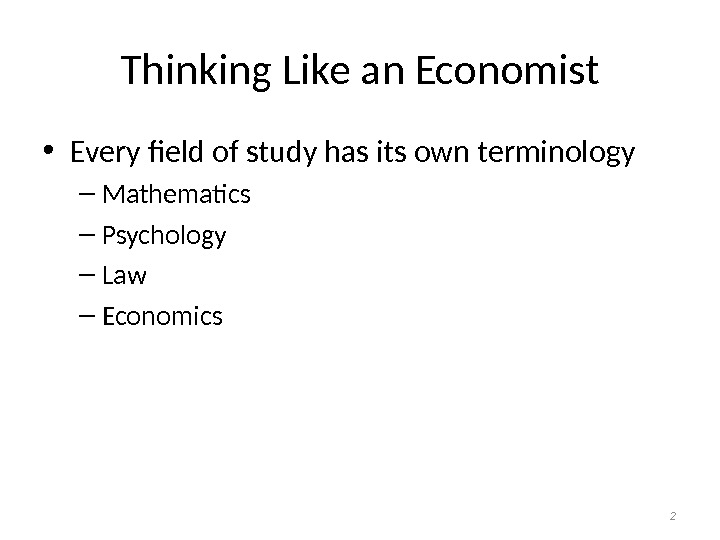





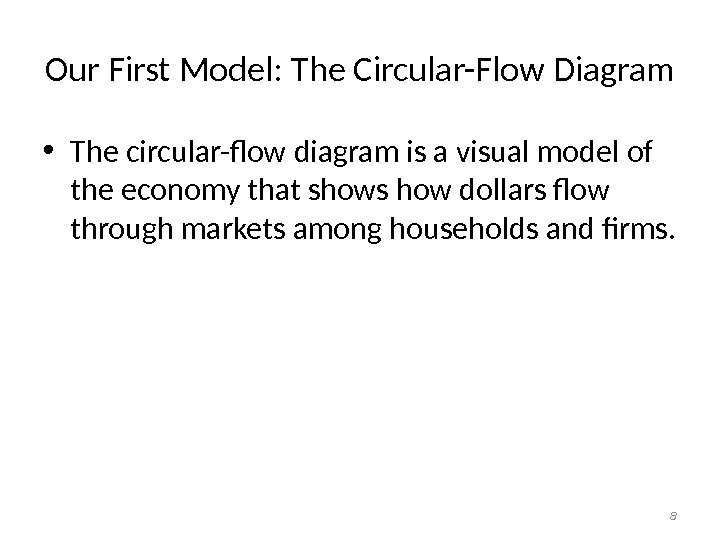





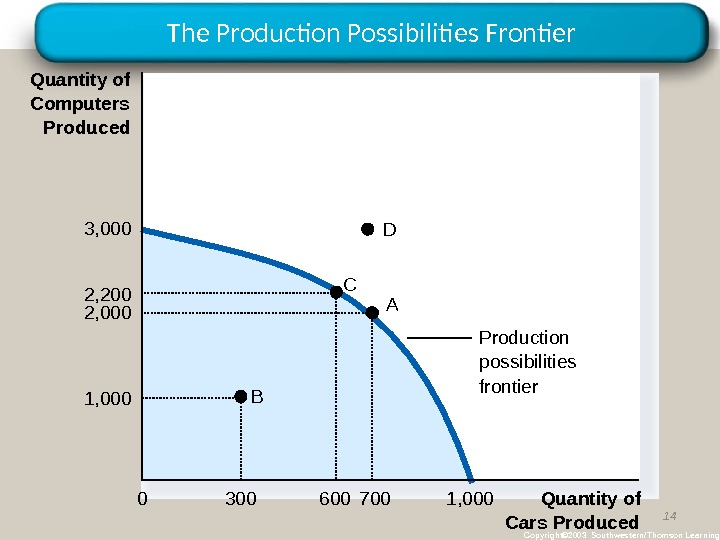








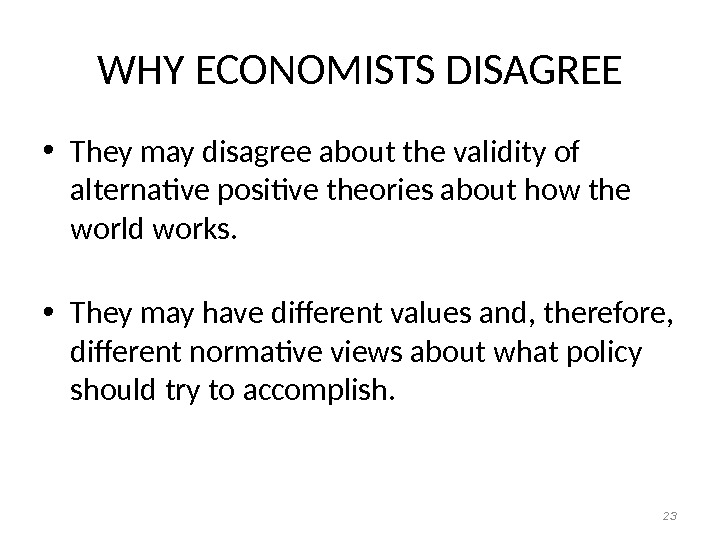
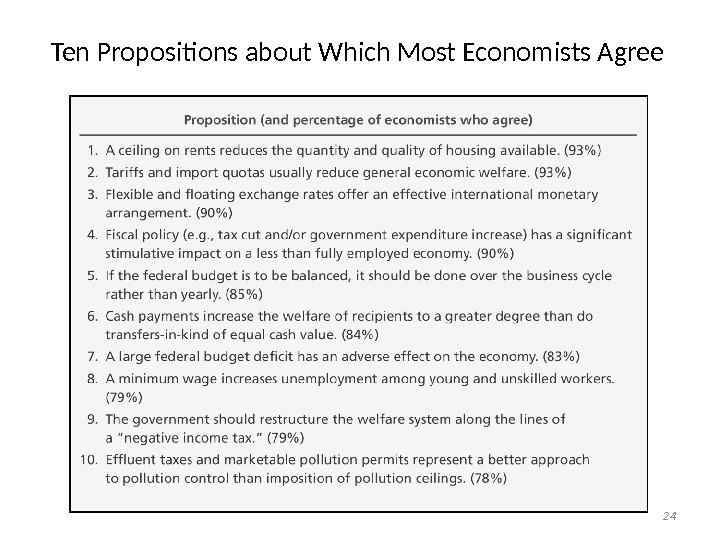


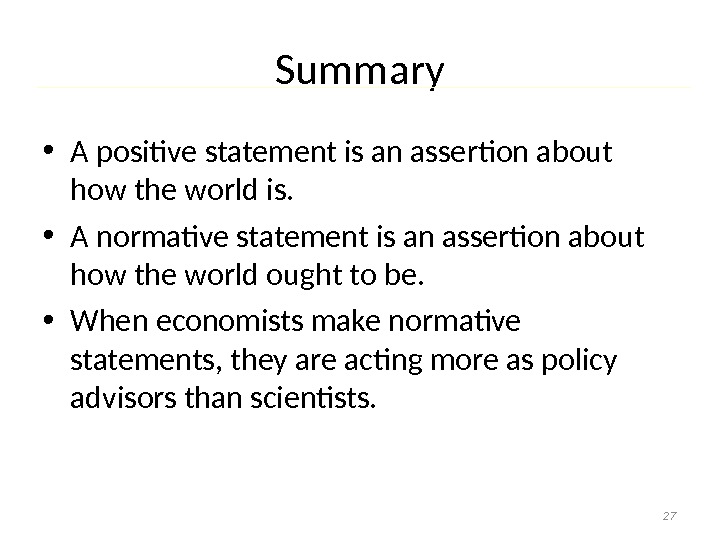

- Размер: 1011.5 Кб
- Количество слайдов: 28
Описание презентации Thinking Like an Economist Thinking Like an по слайдам
 Thinking Like an Economist
Thinking Like an Economist
 Thinking Like an Economist • Every field of study has its own terminology – Mathematics – Psychology – Law – Economics
Thinking Like an Economist • Every field of study has its own terminology – Mathematics – Psychology – Law – Economics
 Thinking Like an Economist • Economics trains you to: – Think in terms of alternatives. – Evaluate the cost of individual and social choices. – Examine and understand how certain events and issues are related.
Thinking Like an Economist • Economics trains you to: – Think in terms of alternatives. – Evaluate the cost of individual and social choices. – Examine and understand how certain events and issues are related.
 The economist as a scientist • The economic way of thinking. . . – Involves thinking analytically and objectively. – Makes use of the scientific method.
The economist as a scientist • The economic way of thinking. . . – Involves thinking analytically and objectively. – Makes use of the scientific method.
 The Scientific Method: Observation, Theory, and More Observation • Uses abstract models to help explain how a complex, real world operates. • Develops theories, collects, and analyzes data to evaluate theories.
The Scientific Method: Observation, Theory, and More Observation • Uses abstract models to help explain how a complex, real world operates. • Develops theories, collects, and analyzes data to evaluate theories.
 The Role of Assumptions • Economists make assumptions in order to make the world easier to understand. • The art in scientific thinking is deciding which assumptions to make. • Economists use different assumptions to answer different questions.
The Role of Assumptions • Economists make assumptions in order to make the world easier to understand. • The art in scientific thinking is deciding which assumptions to make. • Economists use different assumptions to answer different questions.
 Economic Models • Economists use models to simplify reality in order to improve our understanding of the world • Two of the most basic economic models include: – The Circular Flow Diagram – The Production Possibilities Frontier
Economic Models • Economists use models to simplify reality in order to improve our understanding of the world • Two of the most basic economic models include: – The Circular Flow Diagram – The Production Possibilities Frontier
 Our First Model: The Circular-Flow Diagram • The circular-flow diagram is a visual model of the economy that shows how dollars flow through markets among households and firms.
Our First Model: The Circular-Flow Diagram • The circular-flow diagram is a visual model of the economy that shows how dollars flow through markets among households and firms.
 The Circular Flow 9 Spending Goods and services bought. Revenue Goods and services sold Labor, land, and capital Income = Flow of inputs and outputs = Flow of Euros. Factors of production Wages, rent, and profit FIRMS • Produce and sell goods and services • Hire and use factors of production • Buy and consume goods and services • Own and sell factors of production HOUSEHOLDS • Households sell • Firms buy. MARKETS FOR FACTORS OF PRODUCTION • Firms sell • Households buy MARKETS FOR GOODS AND SERVICES
The Circular Flow 9 Spending Goods and services bought. Revenue Goods and services sold Labor, land, and capital Income = Flow of inputs and outputs = Flow of Euros. Factors of production Wages, rent, and profit FIRMS • Produce and sell goods and services • Hire and use factors of production • Buy and consume goods and services • Own and sell factors of production HOUSEHOLDS • Households sell • Firms buy. MARKETS FOR FACTORS OF PRODUCTION • Firms sell • Households buy MARKETS FOR GOODS AND SERVICES
 Our First Model: The Circular-Flow Diagram • Firms – Produce and sell goods and services – Hire and use factors of production • Households – Buy and consume goods and services – Own and sell factors of production
Our First Model: The Circular-Flow Diagram • Firms – Produce and sell goods and services – Hire and use factors of production • Households – Buy and consume goods and services – Own and sell factors of production
 Our First Model: The Circular-Flow Diagram • Markets for Goods and Services – Firms sell – Households buy • Markets for Factors of Production – Households sell – Firms buy
Our First Model: The Circular-Flow Diagram • Markets for Goods and Services – Firms sell – Households buy • Markets for Factors of Production – Households sell – Firms buy
 Our First Model: The Circular-Flow Diagram • Factors of Production – Inputs used to produce goods and services – Land, labor, and capital
Our First Model: The Circular-Flow Diagram • Factors of Production – Inputs used to produce goods and services – Land, labor, and capital
 Our Second Model: The Production Possibilities Frontier • The production possibilities frontier is a graph that shows the combinations of output that the economy can possibly produce given the available factors of production and the available production technology.
Our Second Model: The Production Possibilities Frontier • The production possibilities frontier is a graph that shows the combinations of output that the economy can possibly produce given the available factors of production and the available production technology.
 The Production Possibilities Frontier 14 Copyright© 2003 Southwestern/Thomson Learning. Production possibilities frontier. A B C Quantity of Cars Produced 2, 200 6001, 000 3000 7002, 0003, 000 1, 000 Quantity of Computers Produced
The Production Possibilities Frontier 14 Copyright© 2003 Southwestern/Thomson Learning. Production possibilities frontier. A B C Quantity of Cars Produced 2, 200 6001, 000 3000 7002, 0003, 000 1, 000 Quantity of Computers Produced
 Our Second Model: The Production Possibilities Frontier • Concepts Illustrated by the Production Possibilities Frontier – Efficiency – Tradeoffs – Opportunity Cost – Economic Growth
Our Second Model: The Production Possibilities Frontier • Concepts Illustrated by the Production Possibilities Frontier – Efficiency – Tradeoffs – Opportunity Cost – Economic Growth
 A Shift in the Production Possibilities Frontier 16 Copyright © 2004 South-Western. E Quantity of Cars Produced 2, 000 7002, 100 750 04, 000 3, 000 1, 000 Quantity of Computers Produced
A Shift in the Production Possibilities Frontier 16 Copyright © 2004 South-Western. E Quantity of Cars Produced 2, 000 7002, 100 750 04, 000 3, 000 1, 000 Quantity of Computers Produced
 Microeconomics and Macroeconomics • Microeconomics focuses on the individual parts of the economy. – How households and firms make decisions and how they interact in specific markets • Macroeconomics looks at the economy as a whole. – Economy-wide phenomena, including inflation, unemployment, and economic growth
Microeconomics and Macroeconomics • Microeconomics focuses on the individual parts of the economy. – How households and firms make decisions and how they interact in specific markets • Macroeconomics looks at the economy as a whole. – Economy-wide phenomena, including inflation, unemployment, and economic growth
 The economist as policy advisor • When economists are trying to explain the world, they are scientists. • When economists are trying to change the world, they are policy advisor.
The economist as policy advisor • When economists are trying to explain the world, they are scientists. • When economists are trying to change the world, they are policy advisor.
 Positive versus normative analysis • Positive statements are statements that attempt to describe the world as it is. – Called descriptive analysis • Normative statements are statements about how the world should be. – Called prescriptive analysis
Positive versus normative analysis • Positive statements are statements that attempt to describe the world as it is. – Called descriptive analysis • Normative statements are statements about how the world should be. – Called prescriptive analysis
 Positive versus normative analysis • Positive or Normative Statements? – An increase in the minimum wage will cause a decrease in employment among the least-skilled. – POSITIVE – Higher federal budget deficits will cause interest rates to increase. – POSITIV
Positive versus normative analysis • Positive or Normative Statements? – An increase in the minimum wage will cause a decrease in employment among the least-skilled. – POSITIVE – Higher federal budget deficits will cause interest rates to increase. – POSITIV
 Positive versus normative analysis • Positive or Normative Statements? – The income gains from a higher minimum wage are worth more than any slight reductions in employment. NORMATIVE – State governments should be allowed to collect from tobacco companies the costs of treating smoking-related illnesses among the poor. NORMATIV
Positive versus normative analysis • Positive or Normative Statements? – The income gains from a higher minimum wage are worth more than any slight reductions in employment. NORMATIVE – State governments should be allowed to collect from tobacco companies the costs of treating smoking-related illnesses among the poor. NORMATIV
 Economists in Washington and Helsinki… • . . . serve as advisers in the policymaking process of the three branches of government: – Legislative – Executive – Judicial
Economists in Washington and Helsinki… • . . . serve as advisers in the policymaking process of the three branches of government: – Legislative – Executive – Judicial
 WHY ECONOMISTS DISAGREE • They may disagree about the validity of alternative positive theories about how the world works. • They may have different values and, therefore, different normative views about what policy should try to accomplish.
WHY ECONOMISTS DISAGREE • They may disagree about the validity of alternative positive theories about how the world works. • They may have different values and, therefore, different normative views about what policy should try to accomplish.
 Ten Propositions about Which Most Economists Agree
Ten Propositions about Which Most Economists Agree
 Summary • Economists try to address their subjects with a scientist’s objectivity. – They make appropriate assumptions and build simplified models in order to understand the world around them. – Two simple economic models are the circular-flow diagram and the production possibilities frontier.
Summary • Economists try to address their subjects with a scientist’s objectivity. – They make appropriate assumptions and build simplified models in order to understand the world around them. – Two simple economic models are the circular-flow diagram and the production possibilities frontier.
 Summary • Economics is divided into two subfields: – Microeconomists study decision-making by households and firms in the marketplace. – Macroeconomists study the forces and trends that affect the economy as a whole
Summary • Economics is divided into two subfields: – Microeconomists study decision-making by households and firms in the marketplace. – Macroeconomists study the forces and trends that affect the economy as a whole
 Summary • A positive statement is an assertion about how the world is. • A normative statement is an assertion about how the world ought to be. • When economists make normative statements, they are acting more as policy advisors than scientists.
Summary • A positive statement is an assertion about how the world is. • A normative statement is an assertion about how the world ought to be. • When economists make normative statements, they are acting more as policy advisors than scientists.
 Summary • Economists who advise policymakers offer conflicting advice either because of differences in scientific judgments or because of differences in values. • At other times, economists are united in the advice they offer, but policymakers may choose to ignore it.
Summary • Economists who advise policymakers offer conflicting advice either because of differences in scientific judgments or because of differences in values. • At other times, economists are united in the advice they offer, but policymakers may choose to ignore it.
